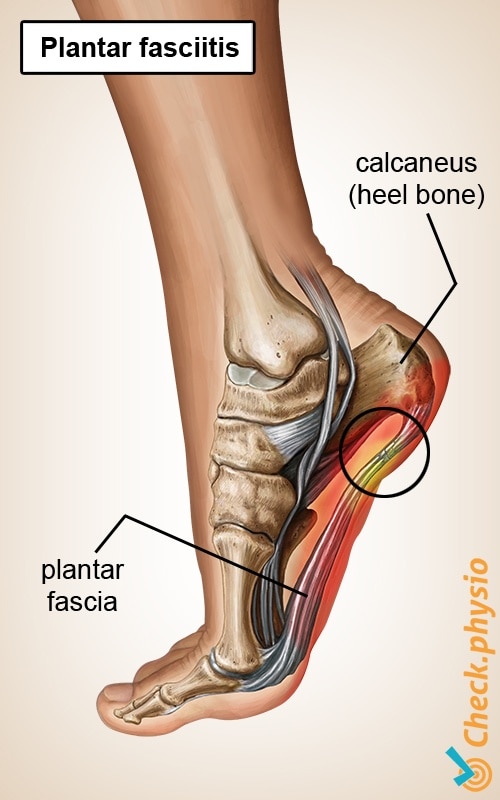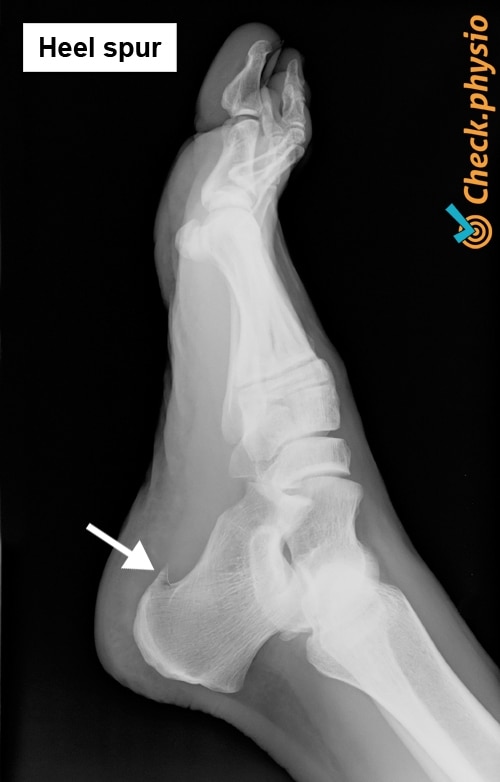Plantar fasciitis
Plantar fasciopathy / jogger's heel / heel spur / plantar fasciosis
Heel pain can have various causes. Symptoms on the underside of the foot and the heel are often referred to as a "heel spur", however this is not always correct.

The terms "plantar fasciitis", "plantar fasciosis" and "calcaneal spur" are often used interchangeably. All three can be used to describe heel pain when walking. The various presentations are discussed in this article.
Description of condition
A thick, fibrous band of connective tissue, called the "plantar fascia" is located under the sole of the foot. It runs along the bottom of the heel bone (the calcaneus) to the base of the toes. The fascia is particularly strong and supports the entire foot. The fascia is forcefully stretched when walking or when standing on your toes.
Plantar fasciitis and plantar fasciopathy
If the fascia becomes inflamed, we refer to this as plantar fasciitis. This is not the only case. "Plantar fasciosis" can also occur. This means that the quality and structure of the fascia deteriorates, making it more vulnerable. Fasciitis and plantar fasciosis can both result in very irritating pain on the underside of the foot while walking.
Heel spur
A heel spur or calcaneal spur is a thorn-shaped calcification at the site where the fascia attaches to the heel bone. Research has demonstrated that the majority of elderly people have heel spurs. However, this does not always result in symptoms. A heel spur probably develops as a result of prolonged compression of a small surface area of the heel bone. It is a gradual process that develops as we age.
The excessive bone formation associated with a heel spur can start to irritate the surrounding structures in the immediate vicinity. However, it is thought that in some cases the heel spur is actually a functional adaptation by the body to protect the heel bone from overloading.
Cause and history
The symptoms usually occur while walking or standing for extended periods. People with excess weight are more likely to suffer heel spurs.
Signs & symptoms
- Pain on the underside of the foot at the site where the plantar fascia attaches to the heel bone.
- Pressure on the site where the fascia attaches to the heel bone is painful.
- Pain while walking or standing.
- Start-up pain may occur. In that case, there are more symptoms when the patient has not walked for some time (for example in the morning or after sitting in a chair for an extended period).
- In some cases the heel fat pad is swollen.
- Passive fully-extending of the toes may exacerbate the symptoms (stretching of the fascia).
Diagnosis
Treatment
Treatment may be a lengthy process. Excessive pressure on the heel bone must be relieved. There are a number of options to achieve this, including weight loss, insoles, less walking/running and not walking in socks or bare feet.
The fascia is also treated, to improve its quality and structure. This is achieved by stretching exercises and (eccentric) strength training.
Sometimes it can help to buy good quality footwear with a rigid sole. The soles of these shoes do not bend so much while walking, meaning that the toes cannot flex too far upward. This prevents additional stretching of the fascia.
Exercises
Take a look at the online exercise program here with exercises for plantar fasciitis.
You can check your symptoms using the online physiotherapy check or make an appointment with a physiotherapy practice in your locality.

References
Nugteren, K. van & Winkel, D. (2009). Onderzoek en behandeling van de voet. Houten: Bohn Stafleu van Loghum.
Verhaar, J.A.N. & Linden, A.J. van der (2005). Orthopedie. Houten: Bohn Stafleu van Loghum.



